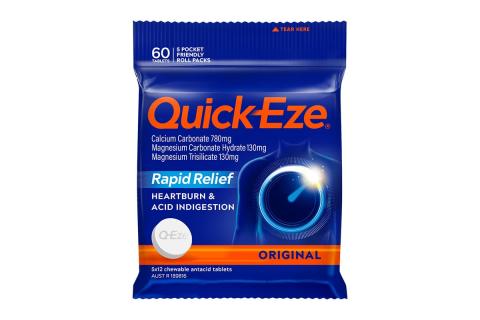Your Guide to Acid Reflux
Ever experienced that unwelcome burn in your chest just when you’re about to dig into your favourite meal or unwind with friends? Acid reflux doesn’t care about your plans – it can disrupt a good time and leave you feeling uncomfortable. But here’s the thing: you shouldn’t have to sacrifice enjoying life’s pleasure because of it.
We understand the frustration. Acid reflux can strike unexpectedly, causing that discomfort. While reaching for quick fixes like antacids can provide rapid relief, gaining a deeper understanding of acid reflux can significantly improve your lifestyle.
Let’s break down what acid reflux is, why it happens and how you can navigate it without missing out on the flavours and moments that matter most.
What is Acid Reflux?
Ever feel like there's a little fire in your chest after a meal? When acid flows from inside your stomach into your esophagus and throat, it’s called acid reflux, which could be the cause of that fiery feeling. This journey of acid can lead to a range of symptoms, making you feel uncomfortable and disrupting your plans.
Though "acid reflux" and "heartburn" are often used interchangeably, they're not quite the same. Acid reflux is the process causing discomfort, while heartburn is the burning sensation you feel in your chest or throat. Imagine a fire rising from your stomach, making its way up your esophagus – that's heartburn, a key symptom of acid reflux.[1]
Understanding acid reflux helps you manage those pesky symptoms better. Various triggers, from what you eat to your daily habits, can set off acid reflux. Recognising and addressing these triggers can help keep that little fire under control and let you enjoy life without constant discomfort.
Acid Reflux Causes
Acid reflux doesn't pick favourites. Whether it's that spicy meal you couldn't resist or the stress of a hectic day, various factors can trigger acid reflux. We’ve broken down some of the common causes of acid reflux below.
Dietary Triggers of Reflux

Acid reflux can be a real hassle, especially when it comes to what you eat. Common culprits include spicy foods, fatty or fried foods, citrus fruits, tomatoes, caffeine, carbonated drinks and alcohol. These can relax the valve that keeps stomach acid where it belongs, leading to that burning feeling. Figuring out your food triggers and avoiding them can make a big difference in keeping acid reflux at bay. [2]
Lifestyle Habits

Understanding the causes of acid reflux involves more than just watching what you eat. Managing acid reflux is also about your daily habits and lifestyle. Habits like smoking, eating large meals or being overweight can all play a part in causing acid reflux. By becoming more aware of these daily habits and making mindful adjustments, you can effectively manage acid reflux symptoms and improve your digestive comfort. [3]
Keep in mind, we’ve mentioned the usual suspects above, but everyone is different. Start here to figure out what's causing your acid reflux and make some tweaks to your diet. Small changes can make a big difference in keeping those fiery episodes at bay and making you feel better overall.
Looking to learn more about reflux?
Explore our blog to learn more about acid reflux, uncover its root causes and find effective ways to get relief.

Common Digestive Disorders
Suffering from that burning chest pain or a sour taste after meals? This guide dives into common digestive issues like heartburn, indigestion, and acid reflux. Learn how to recognise the signs, understand what triggers them, and discover natural remedies for fast relief. Get back to enjoying your day without the discomfort!
Learn about common digestive disorders
Understanding Acid Reflux Symptoms and Their Effects
Acid reflux can manifest in various ways, from the classic heartburn sensation to less common symptoms that may surprise you. Here’s a few symptoms of reflux to watch out for:
Regurgitation: Acid, foods or liquids backwashing from your stomach into your throat after eating is also called regurgitation. You might notice the sour taste of the acid.[4]
Heartburn: Acid burns the tissues in your esophagus. When this happens in your chest, its heartburn. When it happens in your stomach its indigestion.[4]
Nausea: Stomach acid flowing into the esophagus and throat may make you feel nauseous, because its often accompanied by a sour taste in the mouth and tends to worsen after meals or when lying down. [4]
Sore throat: When acid rises into your throat, it can cause soreness or irritation. This might create the sensation of a lump in your throat or make it difficult to swallow. [5]
These are just a few common symptoms of acid reflux, but everyone’s experience can differ. While some may have mild discomfort, others might suffer from stronger symptoms. Spotting these symptoms early can help in managing your discomfort and treating your reflux effectively. Remember to always seek medical advice is your symptoms persist or if they frequently disrupt your daily lifestyle.
Ways to Manage, Prevent and Treat Acid Reflux

Taking control of acid reflux doesn't mean you have to give up your favourite foods or change your entire lifestyle. Simple tweaks can make a big difference.
Simple Lifestyle Adjustments
There are a few small lifestyle tweaks that can help manage acid reflux symptoms such as [6]:
- Maintaining a healthy weight
- Eating smaller, more frequent meals can prevent the stomach from becoming too full.
- Explore ways to manage your stress like meditation, yoga or breathing exercises.
Fine-tune your Diet
Start by identifying and steering clear of triggers which can stir up your discomfort. Plus, take your time to enjoy meals in order to lower the pressure on your gut making digestion smoother.[7] These simple changes to your diet and eating habits can go a long way in helping you feel your best.
Treatments for Managing Symptoms of Acid Reflux
When it comes to treating the symptoms of acid reflux, there are a few different options that suit different needs. Over-the-counter choices include antacids, which work to neutralise stomach acids and provide rapid relief from symptoms such as heartburn and indigestion. H2 blockers and proton pump inhibitors also assist with reducing acid in the stomach.[7]
Need some help for treating your acid reflux symptoms?
While dietary adjustments and lifestyle tweaks can help you a lot, there are times when you need rapid relief. Quick-Eze® offers a range of antacids which provide fast-acting relief with flavours that make managing symptoms of acid reflux, such as heartburn, a bit more enjoyable. Whether you’re into tablets or chewables, our options can provide the relief you need, right when you need it.
|
Image

|
Image

|
Image

|
|
Quick-Eze® Original Tablet Rapid Heartburn & Indigestion Relief Each convenient on-the-go stick pack fits easily in your purse or pocket, so you can relieve heartburn and get back to enjoying life's delicious moments, wherever you are. |
Quick-Eze® Chewy Peppermint Rapid Heartburn & Indigestion Relief Our Peppermint Chewy antacids come in convenient, pocket-sized packs and are a delicious way to relieve heartburn. |
Quick-Eze® Chewy Forest Berry Rapid Heartburn & Indigestion Relief These handy chewy antacids fit anywhere, so you can relieve discomfort wherever it strikes. Pop a chewable tablet, feel the relief, and get back to enjoying life's delicious adventures, fully prepared! |
| See more about Quick-Eze® Original | See more about Quick-Eze® Peppermint Chewy | See more about Quick-Eze® Forest Berry |
[1] https://www.webmd.com/heartburn-gerd/what-is-acid-reflux-disease
[2] https://www.healthdirect.gov.au/gord-reflux
[3] https://www.webmd.com/heartburn-gerd/common-causes-acid-reflux-disease
[5] https://my.clevelandclinic.org/health/diseases/17019-acid-reflux-gerd
[6] https://www.nhs.uk/conditions/heartburn-and-acid-reflux/
[7] https://www.webmd.com/heartburn-gerd/reflux-disease-gerd-1
Frequently asked questions about Acid Reflux
What foods trigger acid reflux?
A range of different foods are known to trigger acid reflux symptoms because of their impact on the digestive system. Spicy foods, high-fat and fried foods, citrus fruits along with acidic tomato-based products such as sauces, are all common culprits due to their acidity. Individual triggers can vary, so it's helpful for anyone that may be experiencing acid reflux to keep a food diary to identify specific foods that may worsen their symptoms. Then, once you’ve pinpointed those trigger foods, you’re better equipped to managing your diet.
What does acid reflux feel like?
Acid reflux typically feels like a burning sensation in the chest, often referred to as heartburn. This discomfort can sometimes rise up into the throat, accompanied by a sour or bitter taste in the mouth. Some may also experience regurgitation of acidic stomach contents into the throat or mouth, leading to a feeling of discomfort or irritation. Symptoms can worsen after eating, when lying down, or during the night. Some people may also feel a sensation of food or liquid coming back up into the throat, known as regurgitation. It's important to remember that we’re all different, so symptoms can vary in intensity and frequency between individuals.
What causes acid reflux?
Acid reflux happens when stomach acid flows back up into the esophagus. This happens when the lower esophageal sphincter (LES), a ring of muscle between the esophagus and stomach, relaxes or doesn't close properly. The different causes of acid reflux can include certain foods, obesity, pregnancy, smoking, and certain medications. Managing diet and lifestyle factors can often help reduce symptoms of acid reflux.
How to prevent acid reflux.
To prevent acid reflux, adopting lifestyle habits that minimise the risk of stomach acid flowing into the esophagus will help to steer clear of uncomfortable symptoms. Here are some methods to try:
- Start by making dietary modifications, such as avoiding trigger foods like spicy or fatty foods, caffeine, chocolate, and citrus fruits.
- Eat smaller, more frequent meals and avoiding heavy meals close to bedtime can also reduce the likelihood of experiencing acid reflux symptoms.
- Maintain a healthy weight through balanced diet and regular as excess weight can put pressure on the abdomen.
- Avoid smoking and excessive alcohol consumption, as both can relax the lower esophageal sphincter (LES), making it easier for acid to reflux into the esophagus.
- Manage stress through techniques like yoga, meditation, or deep breathing exercises.
Always consult with a healthcare provider before starting any new medications or supplements. By integrating these preventive measures into daily routines, you may be able to reduce the frequency and severity of acid reflux episodes.
How to get rid of acid reflux.
To manage acid reflux, focus on dietary adjustments like avoiding trigger foods and eating smaller meals. Lifestyle changes such as maintaining a healthy weight, not smoking, and elevating the head of the bed can also help. Identifying and avoiding personal triggers is important so be sure to consult with a healthcare professional for personalised advice.
